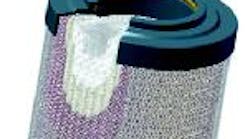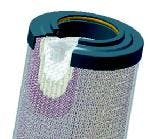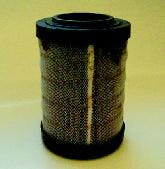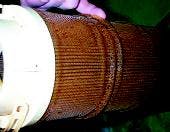When selecting a filter element for a hydraulic system, consider the compatibility of the filter with the system fluid. Particulate contaminants, acids, water, and air can alter chemistry of fluids over time. Increases in fluid temperatures will accelerate the rate of chemical change. These variables pose a threat to the integrity of the filter element's materials of construction.
The nature of fluids
The principle factors affecting how a filter element reacts to a fluid are oxidation, hydrolysis, and temperature.
Oxidation, the union of oil and oxygen, can have a catalytic effect on the fluid. Once this chemical reaction begins, acids can form that cause corrosion. A commonly referenced measure of acidity is the TAN, or total acid number. As the TAN increases, the greater the like-lihood of corrosive effects on metals and some plastics. TAN values vary with different oils, so consult the oil manufacturer to determine when a fluid's TAN is too high.
Furthermore, the rate of oxidation can be accelerated by the presence of particulate contaminants. For example, only a 1% concentration of sludge contamination in a hydraulic fluid can double its normal oxidation rate. This effectively reduces a fluid's useful life by 50%.
In hydrolysis, the presence of water can transmit acidic components of the fluid. The water molecule itself is not a threat of releasing oxygen into the system due to the strong chemical bond between oxygen and hydrogen. The pressures found in a hydraulic circuit are not sufficient to separate the molecule. However, acids created in a system's fluid can dissolve in liquid water. In this way, water is a transmitter of acidity.
Water also reacts with metals. Copper is well known as a catalyst for oxidation reactions, especially in the presence of water. In one ASTM (American Society for Testing and Materials) Oxidation Test, oxidation is measured until a value of 2 (a neutralization number) is achieved. A series of tests proves the effects of copper and water on a fluid. With no water or metal contaminants, the neutralization number reached 0.17 in 3500 hours. Repeating the test with copper contaminant, the neutralization number reached 0.89 after only 3000 hours. Subsequently conducting the test with copper and water contamination, the neutralization number reached 11.2 in just 150 hours.
Temperature contributes significantly to chemistry changes. It affects the rate of chemical reactions, approximately doubling the reaction for every 10° C (18° F) increase in temperature. A reaction may start in a localized area of high temperature. Once the reaction has been initiated, the elevated temperature has a catalytic effect, causing the rate of oxidation to increase.
Element degradation
Pores are clearly visible in clean new elements, and the pores should remain visible even when become clogged with dirt. This is not the case when a filter operates in an acidic fluid. As shown at right, acids, a byproduct of oxidation, have deteriorated the nylon outer sleeve and media support layers of the element. The coated metal cores and adhesive materials of this element were not affected.
Although the end caps of the element are nylon, their mass is much greater than the protective sleeving material's. Therefore, the end caps have a longer life before degradation occurs.
Nylon is a hydrophilic material, meaning it can absorb water — in this particular case, up to about 8% of its weight. Over its service life, the element shown lost its lubricity and eventually hardened, became brittle, and broke apart.
Nylon is a polyamide, which is a compound consisting of repeating structural units that impart flexibility. Acids in water can break down the polymer chain, resulting in the degradation of the nylon. The acids introduced by oxidation and hydrolysis were contained in the water absorbed by the nylon. This particular element was removed from a lubrication circuit in a rotary screw compressor. Compressors are especially vulnerable to oxidation, due to their large intake of ambient air. Additionally, high temperatures are generated in the compression process, which accelerate the chemical reaction.
Fluids themselves have varying degrees of chemical aggressiveness. Issues of compatibility are commonly found in long-life synthetic fluids with a polyglycol or silicone base. These fluids are used primarily in machines that operate at temperatures around 160° F. The fluids remain chemically stable at these temperatures and still achieve long service life. However, at these temperatures, these fluids threaten the integrity of plastic compound materials, such as the nylon component of filter elements.
One solution
Working with synthetic material suppliers, Parker Hannifin developed a proprietary material that is hydrophobic in nature and has been tested in aggressive synthetic fluids. This material absorbs water less than 1% of its weight, as compared to the 8% absorption factor of nylon. An anti-oxidant additive resists the effects of acids formed through oxidation.
Test standards vs field tests
In recognition of compatibility issues, ISO 2943 provides a formal test procedure. The test protocol is for a 72-hr soak in the designated system fluid at 15° C (27° F) above the fluid system manufacturer's recommended operating temperature. This elevated temperature is a practical compromise to achieve an accelerated test rather than a longer test at rated temperature. The ISO lab test provides a universal compatibility test, but it remains a model not affected by system dynamics.
If there are compatibility concerns, a field test is recommended to augment an ISO test so that the filter element will be tested under actual system conditions. It is also suggested the test be conducted through the normal service life of the element.
Dan Busta, is with Parker Hannifin's Hydraulic Filter Div., Metamora, Ohio. Contact him at (419) 644-4311, or click here to visit the Hydraulic Filter division's website.




